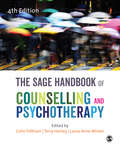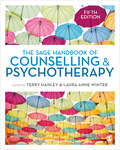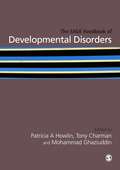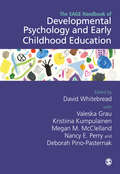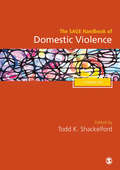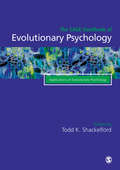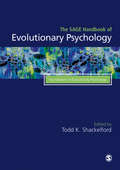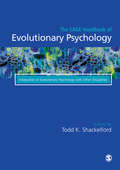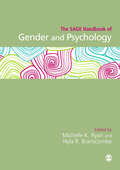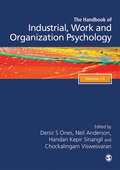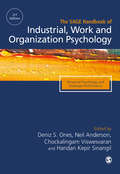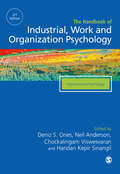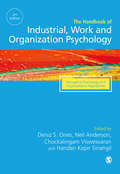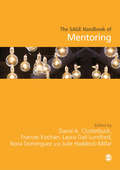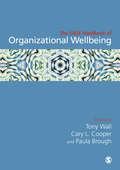- Table View
- List View
The SAGE Handbook of Counselling and Psychotherapy
by Colin Feltham Terry Hanley Dr Laura Anne WinterAt over 600 pages and with more than 100 contributions, this Fourth Edition brings together the essentials of counselling and psychotherapy theory, research, skills and practice. Including new content on assessment, theory, applications and settings, and with new chapter overviews and summaries, this continues to be the most comprehensive and accessible guide to the field for trainees or experienced practitioners.
The SAGE Handbook of Counselling and Psychotherapy
by Terry Hanley Laura Anne WinterThe SAGE Handbook of Counselling and Psychotherapy is the most comprehensive and accessible introduction to the field of counselling and psychotherapy. This handbook supports all levels of training and modalities, providing an essential entry point to theory, practice and research. At over 600 pages and with more than 100 contributions from leading authors in the field, this Fifth Edition brings together the essentials of counselling and psychotherapy theory, research, skills and practice. Each chapter includes a Further Reading section and case studies. Now updated to include the latest research and developments, and with new content on online counselling and working with difference and diversity, it is the most comprehensive and accessible guide to the field for trainees or experienced practitioners. Sections cover: -Counselling and psychotherapy in context -Social justice and intersectionality -Core therapeutic and professional skills -What do people come to therapy for? -Theories and approaches -Lifespan, modalities and technology -Settings.
The SAGE Handbook of Counselling and Psychotherapy
by Terry Hanley Laura Anne WinterThe SAGE Handbook of Counselling and Psychotherapy is the most comprehensive and accessible introduction to the field of counselling and psychotherapy. This handbook supports all levels of training and modalities, providing an essential entry point to theory, practice and research. At over 600 pages and with more than 100 contributions from leading authors in the field, this Fifth Edition brings together the essentials of counselling and psychotherapy theory, research, skills and practice. Each chapter includes a Further Reading section and case studies. Now updated to include the latest research and developments, and with new content on online counselling and working with difference and diversity, it is the most comprehensive and accessible guide to the field for trainees or experienced practitioners. Sections cover: -Counselling and psychotherapy in context -Social justice and intersectionality -Core therapeutic and professional skills -What do people come to therapy for? -Theories and approaches -Lifespan, modalities and technology -Settings.
The SAGE Handbook of Developmental Disorders
by Patricia Howlin Mohammad Ghaziuddin Tony CharmanOver the last four decades, breakthroughs in genetic knowledge, together with the emergence of disciplines devoted to the scientific study of developmental disorders have resulted in much greater awareness of the many different behavioural and genetic phenotypes involved. It is now evident that not only do different disorders have different causes and different manifestations, but different neurological and biochemical bases, different responses to intervention, and different life courses. Reflecting the enormous changes that have taken place in our knowledge and understanding of developmental disorders, this groundbreaking international volume brings this vast and complex field together for the first time. The Editors have collected together the world's leading academic scholars and clinicians, to explore how current research across a range of different disciplines can inform clinical practice and help to improve the lives of individuals and their families.
The SAGE Handbook of Developmental Psychology and Early Childhood Education
by David Whitebread Nancy E. Perry Megan M. McClelland Valeska Grau Kristiina Kumpulainen Deborah Pino-PasternakWith the expertise of a body of international contributors from Australia, Canada, USA, UK, Finland, The Netherlands, Italy, Greece and Chile, this handbook explores key in-depth issues in quality Early Childhood Development and Education. Unlike previous publications in the discipline, this title combines research and practice to investigate emotional and social development, wellbeing and mental health, language, cultural environments, as well as the role of parents in a child′s development. It is divided into six key parts: Part I: Emotional Development Part II: Social Development Part III: Play, Development and Learning Part IV: Memory and Understanding Part V: Learning, Language and Literacy Part VI: Executive Functions, Metacognition and Self-Regulation
The SAGE Handbook of Domestic Violence
by Todd K. ShackelfordThe field of Domestic Violence research has expanded considerably in the past decade and now includes work conducted by researchers in many different disciplines, notably political science, public health, law, psychology, sociology, criminology, anthropology, family studies, and medicine. The SAGE Handbook of Domestic Violence provides a rich overview of the most important theoretical and empirical work in the field, organized by relationship type. The handbook addresses three major areas of research on domestic violence: - Violence against partners - Violence against children - Violence against other family members. This Handbook is a unique and timely publication and a long awaited, valuable resource for the vast amount of Domestic Violence research centres and individual researchers across the globe.
The SAGE Handbook of Domestic Violence
by Todd K. ShackelfordThe field of Domestic Violence research has expanded considerably in the past decade and now includes work conducted by researchers in many different disciplines, notably political science, public health, law, psychology, sociology, criminology, anthropology, family studies, and medicine. The SAGE Handbook of Domestic Violence provides a rich overview of the most important theoretical and empirical work in the field, organized by relationship type. The handbook addresses three major areas of research on domestic violence: - Violence against partners - Violence against children - Violence against other family members. This Handbook is a unique and timely publication and a long awaited, valuable resource for the vast amount of Domestic Violence research centres and individual researchers across the globe.
The SAGE Handbook of Evolutionary Psychology: Applications of Evolutionary Psychology
by Todd K. ShackelfordEvolutionary psychology is an important and rapidly expanding area in the life, social, and behavioral sciences, and this Handbook represents the most comprehensive and up-to-date reference text in the field today. Chapters in this Handbook address real-world and practical applications of evolutionary psychology such as applications to medicine, psychiatry, law, and technology. The SAGE Handbook of Evolutionary Psychology is an essential resource for researchers, graduate students, and advanced undergraduate students in all areas of psychology, and in related disciplines across the life, social, and behavioral sciences. Part 1: Applications to Health and Well-Being Part 2: Applications to Law and Order Part 3: Applications to Technology, Communications, and the Future
The SAGE Handbook of Evolutionary Psychology: Applications of Evolutionary Psychology
by Todd K. ShackelfordEvolutionary psychology is an important and rapidly expanding area in the life, social, and behavioral sciences, and this Handbook represents the most comprehensive and up-to-date reference text in the field today. Chapters in this Handbook address real-world and practical applications of evolutionary psychology such as applications to medicine, psychiatry, law, and technology. The SAGE Handbook of Evolutionary Psychology is an essential resource for researchers, graduate students, and advanced undergraduate students in all areas of psychology, and in related disciplines across the life, social, and behavioral sciences. Part 1: Applications to Health and Well-Being Part 2: Applications to Law and Order Part 3: Applications to Technology, Communications, and the Future
The SAGE Handbook of Evolutionary Psychology: Foundations of Evolutionary Psychology
by Todd K. ShackelfordEvolutionary psychology is an important and rapidly expanding area in the life, social, and behavioral sciences, and this Handbook represents the most comprehensive and up-to-date reference text in the field today. Chapters in this Handbook address foundational theories and methodological approaches, providing a rich overview of the most important theoretical and empirical work in the field. The SAGE Handbook of Evolutionary Psychology is an essential resource for researchers, graduate students, and advanced undergraduate students in all areas of psychology, and in related disciplines across the life, social, and behavioral sciences. Part 1: Foundations of Evolution Part 2: Middle-Level Evolutionary Theories Part 3: Research Methods and Strategies
The SAGE Handbook of Evolutionary Psychology: Foundations of Evolutionary Psychology
by Todd K. ShackelfordEvolutionary psychology is an important and rapidly expanding area in the life, social, and behavioral sciences, and this Handbook represents the most comprehensive and up-to-date reference text in the field today. Chapters in this Handbook address foundational theories and methodological approaches, providing a rich overview of the most important theoretical and empirical work in the field. The SAGE Handbook of Evolutionary Psychology is an essential resource for researchers, graduate students, and advanced undergraduate students in all areas of psychology, and in related disciplines across the life, social, and behavioral sciences. Part 1: Foundations of Evolution Part 2: Middle-Level Evolutionary Theories Part 3: Research Methods and Strategies
The SAGE Handbook of Evolutionary Psychology: Integration of Evolutionary Psychology with Other Disciplines
by Todd K. ShackelfordEvolutionary psychology is an important and rapidly expanding area in the life, social, and behavioral sciences, and this Handbook represents the most comprehensive and up-to-date reference text in the field today. Chapters in this Handbook address theory and research that integrates evolutionary psychology with other life, social, and behavioral sciences, as well as with the humanities. The SAGE Handbook of Evolutionary Psychology is an essential resource for researchers, graduate students, and advanced undergraduate students in all areas of psychology, and in related disciplines across the life, social, and behavioral sciences. Part 1: Integration within Psychology Part 2: Integration with other Life, Social, and Behavioral Sciences Part 3: Integration with the Humanities
The SAGE Handbook of Evolutionary Psychology: Integration of Evolutionary Psychology with Other Disciplines
by Todd K. ShackelfordEvolutionary psychology is an important and rapidly expanding area in the life, social, and behavioral sciences, and this Handbook represents the most comprehensive and up-to-date reference text in the field today. Chapters in this Handbook address theory and research that integrates evolutionary psychology with other life, social, and behavioral sciences, as well as with the humanities. The SAGE Handbook of Evolutionary Psychology is an essential resource for researchers, graduate students, and advanced undergraduate students in all areas of psychology, and in related disciplines across the life, social, and behavioral sciences. Part 1: Integration within Psychology Part 2: Integration with other Life, Social, and Behavioral Sciences Part 3: Integration with the Humanities
The SAGE Handbook of Gender and Psychology
by Nyla R Branscombe Michelle K. RyanThe SAGE Handbook of Gender and Psychology is a unique, state-of-the-art synthesis of the known work, combined with current research trends, in the broad field of gender and psychology. In the past 35 years academic publications on the subject have increased tenfold, and this level of activity as well the diversity of research looks set to increase in the coming years too. The time is ideal for a systematic review of the field. Contributions come from academics around the world and many different disciplines, and as a result multiple perspectives and a diversity of methodologies are presented to understand gender and its implications for behaviour. Chapters cover a wide variety of topics, theoretical approaches, contexts, and social issues; they also critically examine the key issues and current debates. Both advanced students and scholars will find extensive range and depth in the topics covered across the Handbook's 29 chapters. Published as a single volume, the handbook is aimed at individuals as well as the library market. The SAGE Handbook of Gender and Psychology will have mass appeal across the field of psychology, including social psychology and gender and psychology, as well a number of other subject groups such as gender studies, sociology, organizational behaviour and political science.
The SAGE Handbook of Industrial, Work & Organizational Psychology, 3v: Personnel Psychology and Employee Performance; Organizational Psychology; Managerial Psychology and Organizational Approaches
by Deniz S. Ones Neil Anderson Handan Kepir Sinangil Chockalingam ViswesvaranThe second edition of this best-selling Handbook presents a fully updated and expanded overview of research, providing the latest perspectives on the analysis of theories, techniques, and methods used by industrial, work, and organizational psychologists. Building on the strengths of the first edition, key additions to this edition include in-depth historical chapter overviews of professional contexts across the globe, along with new chapters on strategic human resource management; corporate social responsibility; diversity, stress, emotions and mindfulness in the workplace; environmental sustainability at work; aging workforces, among many others. Providing a truly global approach and authoritative overview, this three-volume Handbook is an indispensable resource and essential reading for professionals, researchers and students in the field. Volume One: Personnel Psychology and Employee Performance Volume Two: Organizational Psychology Volume Three: Managerial Psychology and Organizational Approaches
The SAGE Handbook of Industrial, Work & Organizational Psychology: V1: Personnel Psychology and Employee Performance
by Neil Anderson Deniz S Ones Dr Chockalingam Viswesvaran Handan Kepir SinangilThe first volume in The SAGE Handbook of Industrial, Organizational and Work Psychology introduces key concepts in personnel and employee performance from cognitive ability and the psychological predictors used in assessments to employee and team values. The editor and contributors present a clear overview of key research in the areas of behaviour change and how to assess individual job performance – making Volume I indispensable for anyone working in or studying Human Resource Management.
The SAGE Handbook of Industrial, Work & Organizational Psychology: V1: Personnel Psychology and Employee Performance
by Neil Anderson Deniz S Ones Dr Chockalingam Viswesvaran Handan Kepir SinangilThe first volume in The SAGE Handbook of Industrial, Organizational and Work Psychology introduces key concepts in personnel and employee performance from cognitive ability and the psychological predictors used in assessments to employee and team values. The editor and contributors present a clear overview of key research in the areas of behaviour change and how to assess individual job performance – making Volume I indispensable for anyone working in or studying Human Resource Management.
The SAGE Handbook of Industrial, Work & Organizational Psychology: V2: Organizational Psychology
by Neil Anderson Deniz S Ones Dr Chockalingam Viswesvaran Handan Kepir SinangilThe second volume in the SAGE Handbook of Industrial, Organizational and Work Psychology looks in detail at how teams and individuals function and perform. It covers motivation and organizational socialisation as well as the latest research into diversity and organizational culture in the workplace. There are also sections on social networks and how job loss and the experience of unemployment can affect individuals and wider groups within organizations. Part One: Lenses Part Two: Social and Political Order Part Three: Legacies Part Four: Problems and Problematics
The SAGE Handbook of Industrial, Work & Organizational Psychology: V2: Organizational Psychology
by Neil Anderson Deniz S Ones Dr Chockalingam Viswesvaran Handan Kepir SinangilThe second volume in the SAGE Handbook of Industrial, Organizational and Work Psychology looks in detail at how teams and individuals function and perform. It covers motivation and organizational socialisation as well as the latest research into diversity and organizational culture in the workplace. There are also sections on social networks and how job loss and the experience of unemployment can affect individuals and wider groups within organizations. Part One: Lenses Part Two: Social and Political Order Part Three: Legacies Part Four: Problems and Problematics
The SAGE Handbook of Industrial, Work & Organizational Psychology: V3: Managerial Psychology and Organizational Approaches
by Neil Anderson Deniz S Ones Dr Chockalingam Viswesvaran Handan Kepir SinangilThe third volume in The SAGE Handbook of Industrial, Organizational and Work Psychology concentrates on business decision-making and the many factors influencing the adoption and implementation of IWO practices. Chapter topics include utility assessments of interventions, decision-making errors in IWO systems, large-scale interventions and best practices reviews. Volume Three offers a comprehensive overview of the field for anyone working in or studying managerial or organizational psychology.
The SAGE Handbook of Industrial, Work & Organizational Psychology: V3: Managerial Psychology and Organizational Approaches
by Neil Anderson Deniz S Ones Dr Chockalingam Viswesvaran Handan Kepir SinangilThe third volume in The SAGE Handbook of Industrial, Organizational and Work Psychology concentrates on business decision-making and the many factors influencing the adoption and implementation of IWO practices. Chapter topics include utility assessments of interventions, decision-making errors in IWO systems, large-scale interventions and best practices reviews. Volume Three offers a comprehensive overview of the field for anyone working in or studying managerial or organizational psychology.
The SAGE Handbook of Mentoring
by Dr Frances Kochan Dr Julie Haddock-Millar Dr Laura Gail Lunsford Dr Nora Dominguez Professor David Ashley ClutterbuckThe SAGE Handbook of Mentoring provides a scholarly, comprehensive and critical overview of mentoring theory, research and practice across the world. Internationally renowned authors map out the key historical and contemporary research, before considering modern case study examples and future directions for the field. The chapters are organised into four areas: The Landscape of Mentoring The Practice of Mentoring The Context of Mentoring Case Studies of Mentoring Around the Globe This Handbook is a resource for mentoring academics, students and practitioners across a range of disciplines including business and management, education, health, psychology, counselling, and social work.
The SAGE Handbook of Mentoring
by Dr Frances Kochan Dr Julie Haddock-Millar Dr Laura Gail Lunsford Dr Nora Dominguez Professor David Ashley ClutterbuckThe SAGE Handbook of Mentoring provides a scholarly, comprehensive and critical overview of mentoring theory, research and practice across the world. Internationally renowned authors map out the key historical and contemporary research, before considering modern case study examples and future directions for the field. The chapters are organised into four areas: The Landscape of Mentoring The Practice of Mentoring The Context of Mentoring Case Studies of Mentoring Around the Globe This Handbook is a resource for mentoring academics, students and practitioners across a range of disciplines including business and management, education, health, psychology, counselling, and social work.
The SAGE Handbook of Organizational Wellbeing
by Cary L. Cooper Tony Wall Paula BroughThe SAGE Handbook of Organizational Wellbeing is a comprehensive and cutting-edge work providing the latest insights into a range of perspectives on organizational wellbeing, as well as highlighting global wellbeing issues and exploring new contexts. Topics covered include: digital working and social media, LGBTQIA+ identifications and work, suicide at work, refugee workers, and mental health. A multi- and inter-disciplinary work, this handbook embraces ideas and empirical work from a range of fields including psychology, business and management, economics, and science. This handbook draws together current knowledge whilst also outlining emerging issues and directions, making this an invaluable resource for students and researchers spanning a wide array of disciplines. Part 1: Theoretical Perspectives Part 2: International Issues and Contexts Part 3: Developing Organizational Wellbeing Part 4: Emerging Issues and Directions
The SAGE Handbook of Organizational Wellbeing
by Cary L. Cooper Tony Wall Paula BroughThe SAGE Handbook of Organizational Wellbeing is a comprehensive and cutting-edge work providing the latest insights into a range of perspectives on organizational wellbeing, as well as highlighting global wellbeing issues and exploring new contexts. Topics covered include: digital working and social media, LGBTQIA+ identifications and work, suicide at work, refugee workers, and mental health. A multi- and inter-disciplinary work, this handbook embraces ideas and empirical work from a range of fields including psychology, business and management, economics, and science. This handbook draws together current knowledge whilst also outlining emerging issues and directions, making this an invaluable resource for students and researchers spanning a wide array of disciplines. Part 1: Theoretical Perspectives Part 2: International Issues and Contexts Part 3: Developing Organizational Wellbeing Part 4: Emerging Issues and Directions
